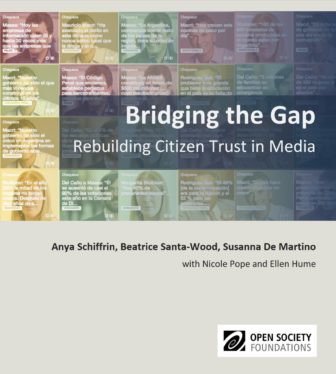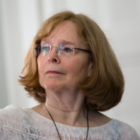Media trust, credibility and echo chambers have been a key subject of discussion in 2017. We understand now how trust in media and other institutions can be destroyed. What’s not clear is how to bring it back once it’s gone.
 Journalists in many countries are experimenting with how to build trust and engage with audiences, and our report examines their efforts. In our study, Bridging the Gap: Rebuilding Citizen Trust in the Media, commissioned by the Open Society Foundation’s Program on Independent Journalism, we profile organizations that are working to build bridges with their readers, viewers and listeners and deliver relevant news to local audiences.
Journalists in many countries are experimenting with how to build trust and engage with audiences, and our report examines their efforts. In our study, Bridging the Gap: Rebuilding Citizen Trust in the Media, commissioned by the Open Society Foundation’s Program on Independent Journalism, we profile organizations that are working to build bridges with their readers, viewers and listeners and deliver relevant news to local audiences.
We surveyed 17 organizations and conducted interviews with representatives of 15 organizations, one of which chose to remain anonymous. Among others we spoke to Chequeado in Argentina, GroundUp in South Africa, Raseef 22 in the Middle East, 263 Chat in Zimbabwe, Krautreporter and Correct!v in Germany, as well as Bristol Cable in the UK. The report also includes an annotated bibliography of academic studies on media trust and media literacy and a list of ongoing initiatives as well as sidebars on past efforts to boost media credibility.
The full report is available here.
Some key survey findings include:
- Although the groups we surveyed are concerned by the broader phenomena of falling trust in media and media credibility, they are also, by necessity, focused on immediate fixes important to their organizations and readerships. Some believe that media credibility depends on engagement with readers. Some place more emphasis on journalism practices, including audience engagement, ethical standards and news gathering practices.
- The outlets we profiled use digital technology to communicate with audiences. Some also involve their readers in sourcing and sometimes verifying information. Some conduct focus groups and online surveys. Responding to comments online is part of their engagement efforts.
- Their audiences are most likely to receive information on mobile phones, followed by laptops, print newspapers and radio. Stories are also seen when picked up by other sites and newspapers and shared widely though social media.
- Comments are made online and are also submitted over email. Half of the outlets say they respond to comments online.
- Some outlets and organizations make personal contact with their audiences. They go into the community, offer trainings and invite readers to contribute to their reporting. Some of our interviewees respond to trolls, but most say that they ignore them.
- Most of the outlets hope to expand their geographic reach, coverage and activities, but few are financially self-sufficient or have the resources to do so.
- The editors we spoke to say that their readers appreciate investigative reporting as well as stories that touch on their daily lives.
- There seems to be a tradeoff between audience size and the quality of content produced. Some groups with large followings (Hivisasa and 263Chat) promote headlines and short snippets rather than carrying out deep investigative reporting. (This finding may be due to our small sample and not signify a broader trend. Raseef22 is one notable exception.)
- Several groups said their audience is different from what their founders had originally expected. The reach of the outlets we surveyed is generally not as diverse as they had hoped. Their audiences tend to be educated and urban and, in some cases, include large diaspora communities.
- The outlets largely cater to niche audiences, but they have broader reach through their online presence and national influence when their stories are picked up by legacy media or other outlets. Sometimes they are able to get on the national agenda (Bristol Cable and GroundUp among others).
- Many of the organizations do not systematically measure their impact. Some monitor traffic, and one produces an “impact report.”
- The groups are likely to provide tangible benefits in the long term because they are seeding the ground for future efforts and offering valuable work experience for the next generation of journalists in their countries.

- As we saw in Publishing for Peanuts (our 2015 report for Open Society Foundations’ Program on Independent Journalism), the organizations we profiled believe that delivering accurate information is a way of gaining credibility in a world of diminishing trust. The organizations maintain that they demonstrate their trustworthiness by providing accurate, objective stories and adhering to strict standards.
- Many organizations reported that further efforts are necessary to build trust with readers. Six of the sites said they reveal their funding sources and four publish their ownership. Five show audiences how their newsrooms work. Fifteen of the organizations surveyed answer “yes” to the question “do people who know your organization trust it?” Nine say that their readers trust their outlet more than other outlets.
- Ten of the organizations explain their story selection process to their readers and eight give them a voice in editorial or business decisions. Twelve said they have “used their readers’ knowledge or expertise when producing a story.”
- When asked to choose which statement they agreed with the most, six picked the following sentence: “The key to a journalist’s credibility has always been telling the truth and that has not changed in the digital era.” Six agreed with the statement that “In the digital era, the key to a journalist’s credibility has changed. You have to tell the truth but you also need to actively convince your readers and society-at-large that you are trustworthy. To achieve this, you need to develop new ways of relating to the public.”
The Open Society Foundation’s Program on Independent Journalism, which commissioned this study, is a donor to GIJN.
 Anya Schiffrin is director of the Technology, Media, and Communications specialization at Columbia University’s School of International and Public Affairs. Her most recent book is African Muckraking: 50 Years of African Investigative Journalism (Jacana: 2017).
Anya Schiffrin is director of the Technology, Media, and Communications specialization at Columbia University’s School of International and Public Affairs. Her most recent book is African Muckraking: 50 Years of African Investigative Journalism (Jacana: 2017).
 Beatrice Louise Santa-Wood recently earned her master’s degree from the School of International and Public Affairs at Columbia University, where she was senior editor of the Journal of International Affairs.
Beatrice Louise Santa-Wood recently earned her master’s degree from the School of International and Public Affairs at Columbia University, where she was senior editor of the Journal of International Affairs.
 Ellen Hume, of International Media Development Advisers, covered the White House for the Wall Street Journal, was research director of MIT’s Center for Civic Media, and director of Harvard’s Shorenstein Center on the Press, Politics and Public Policy.
Ellen Hume, of International Media Development Advisers, covered the White House for the Wall Street Journal, was research director of MIT’s Center for Civic Media, and director of Harvard’s Shorenstein Center on the Press, Politics and Public Policy.
 Nicole Pope is a Swiss journalist and writer based in Berlin. She lived 30 years in Turkey and contributed to numerous publications, serving for 15 years as the Turkey correspondent for Le Monde.
Nicole Pope is a Swiss journalist and writer based in Berlin. She lived 30 years in Turkey and contributed to numerous publications, serving for 15 years as the Turkey correspondent for Le Monde.
 Susanna De Martino is a research assistant for Anya Schiffrin at Columbia University. She studies political science at Barnard College.
Susanna De Martino is a research assistant for Anya Schiffrin at Columbia University. She studies political science at Barnard College.
